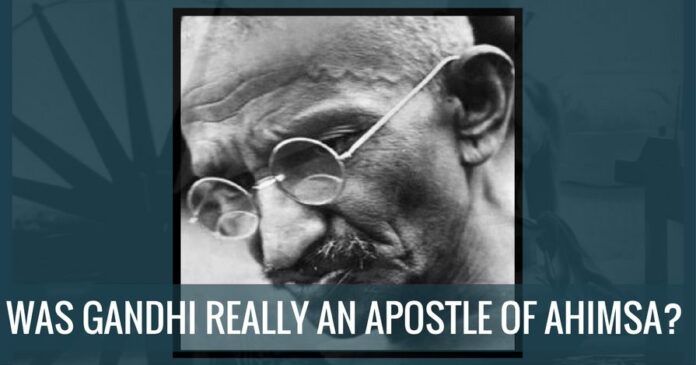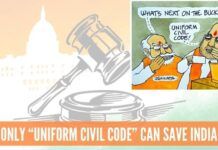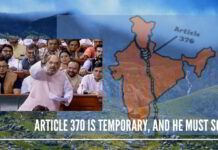
With all the below pieces of evidence, readers must decide whether Gandhi was really committed to non-violence or not
A recent letter in a newspaper invoked Mahatma Gandhi’s belief that “An eye for an eye only ends up making the whole world blind” and “The day the power of love overrules the love of power, the world will know peace.” Incidentally, on 15th June 2007, the United Nations General Assembly decided to establish Gandhi Jayanti as the International Day of Non-Violence.
Yes, for decades now, Indians have believed that Mahatma Gandhi was a patron saint of ahimsa, which in the Hindu, Buddhist and Jain tradition, is respect for all living things and avoidance of violence towards others.
But in the Twitterland of modern India, there is no veneration for names, however big they otherwise have been before “freedom of speech and expression” became a birthright here. Hence, on October 2 this year, criticism rained on Gandhi. He was heckled and mocked.
H.M. Seervai not only threw searchlight erudition on the country’s Constitution, but also startling insight into Gandhi’s non-violence.
However, just 140 characters on a keyboard are only a spontaneous reflection of emotions, not always backed by due diligence. They are ephemeral. In contrast are the words published for posterity with an immense study by a mature mind. And, in respect of Gandhi’s non-violence, we do have such words in the treasury of our Constitutional literature. They have been created by a renowned jurist, eminent lawyer and one who was conferred with a Padma Vibhushan. He was Hormasji “Homi” Maneckji Seervai who twice declined a seat on our Supreme Court. Recognised by the International Bar Association as a “Living Legend of Law”, he refused, with gratitude, the post of India’s Attorney General, writing in his own hand, that to the Law Minister that the best contribution that he could make to the law was not to appear in Court but to “embody in successive editions of his book the correct judicial interpretation of the Constitution”.
In the extensive “Introduction” (called Mainly history) of his three-volume magnum opus called “Constitutional Law of India”, H.M. Seervai not only threw searchlight erudition on the country’s Constitution but also startling insight into Gandhi’s non-violence. Based on researching several cited historical documents of the British rulers, the following excerpts are from that gem of his “Introduction”:
“Gandhi claimed that ahimsa was a fundamental part of his creed. Gandhi’s greatest success in non-violent passive resistance was in South Africa. But his views on non-violence in Indian politics, as well as in international affairs, are not easy to reconcile with his fundamental creed. There is little doubt that Gandhi used non-violence as a political weapon, and was prepared to support, or connive at, violence to secure political goals.
In mid-1940, when Great Britain braced herself to face a German invasion, Gandhi published an “open letter” to “every Briton” urging “cessation of hostilities.”
“First, I will deal with Gandhi’s creed of non-violence in relation to war; and then with his creed of non-violence in relation to the transfer of power.
“During the first World War, in the middle of 1918, at a War Conference presided over by the Viceroy, Gandhi seconded the main resolution in support of recruiting Indians to the army to fight on the side of Britain and her allies. Later, Gandhi wrote to Jinnah and said: Can you not see that if every Home Rule Leaguer became a potent recruiting agency whilst at the same time fighting for constitutional rights we should ensure the passing of the Congress-League scheme?…’Seek ye first the recruiting office and everything will be added unto you.’
“In other words, support for violence and war was justified if it ensured the acceptance of the Congress-League scheme.
“The Second World War was to supply a remarkable example. When that war broke out in 1939, and Lord Linlithgow announced that India was at war, Gandhi refused to support the War on the ground that it involved violence, and he would not support violence even to secure the independence of India. In mid-1940, when Great Britain braced herself to face a German invasion, Gandhi published an “open letter” to “every Briton” urging “cessation of hostilities.” He said:
“No cause, however just, can warrant the indiscriminate slaughter that is going on minute…. I do not want Britain to be defeated, nor do I want her to be victorious in a trial of brute strength…I want you to fight Nazism without arms …I would like you to lay down the arms you have as being useless for saving you or humanity. You will invite Herr Hitler and Signor Mussolini to take what they want of the countries you call your possessions. Let them take possession of your beautiful island, with your many beautiful buildings. You will give all these, but neither your souls nor your minds. If these gentlemen choose to occupy your homes, you will vacate them. If they do not give you free passage out, you will allow yourself, man, woman, and child, to be slaughtered, but you will refuse to owe allegiance to them …. I am telling His Excellency, the Viceroy, that my services are at the disposal of His Majesty’s Government, should they consider them of any practical use in advancing object of any appeal.”
Slaughter from minute to minute was justified if India was immediately granted the substance of independence.
“At first blush, Gandhi’s open letter appears to support the view that non-violence was a part of Gandhi’s basic doctrine. However, there was to be an amazing sequel to his open letter. In 1944, when Gandhi was released from jail, the tide of victory was beginning to flow towards the Allies. In July 1944, Gandhi gave an interview to Gleder of the News Chronicle, London. The gist of the interview was this: the Victory and the Commander- in- Chief could remain in charge of military operations against Germany, Japan and their allies, and India could be used as a base for such military operations, provided that a National Government was immediately formed and Provincial Ministries were restored. The expense of military operations would not be borne in India. In other words, slaughter from minute to minute was justified if India was immediately granted the substance of independence.
“Finally Abdul Gaffar Khan related that at an “… interview (he) told Pyarelal that Gandhiji had promised him that independent India would not fail to come to the rescue of the Pakhtoons if Pakistan oppressed them. Gandhiji repeated that statement to one of Khan Saheb’s relations at Delhi after Independence. Asked what would happen to his non-violence in that event, Gandhiji replied with a laugh: ‘Don’t you worry about my non-violence; I shall take care of it’.
“So, here too, non-violence would be given up and violence supported, or connived at, to secure a desirable political end.
“Turning to transfer power to India, a Note made by Major Wyatt of his conversation with Gandhi on April 13, 1946, contains, inter alia, the following:
“He (Gandhi) told me that there may well have to be a blood-bath in India before her problems are solved. He would urge non-violence in Congress but does not expect them to observe it. The only thing he expects from Congress in the event of civil war is that they will fight decently and take only one tooth for one tooth, not a hundred teeth for one tooth as the British do.”
So, with all the above evidence, readers must decide whether Gandhi was really committed to non-violence or not. Or, was he really a Chatur Bania?
Note:
1. The views expressed here are those of the author and do not necessarily represent or reflect the views of PGurus.
- To Editors’ Guild; May we also have our say… please? - July 17, 2019
- Farooq Sahab is either down with dementia or he is a congenital liar? - July 8, 2019
- Shah Bano, Muslims in gutter &Zakaria’s secularism - June 30, 2019











If he is a man of human failings, then should we continue calling him “Mahatma”. His contributions to our independence struggle is huge and unimpeachable, but then so are that of a great many others. Our attempt to present only Gandhi and Nehru as the apostles of our freedom struggle is unimaginative to say the least. If not for the World War II breaking their backs and the Navy’s mutiny in Mumbai, the British might have remained for a few more decades. So we should recognise the history for what it is and stop lionising a couple of contributors.
The unfortunate truth is that the decades of our independence has equally destroyed our historical truths as much as the centuries of foreign rule.
Gandhi was a British stooge
We Indians have the habit of hero worship. Glad Mr Lavakare wrote this article. Also happy to read the comments of Justice Seervai.
Mahatma Gandhi had a major role in freedom struggle. More than once he brought the warring factions together . But we can’t ignore some of his failings. His sidelining of Bose, fighting only for Indians in South Africa and not for the blacks( in fact he said that Indians and blacks should not be forced to live in the same suburbs in Johannesburg, the British Indians should admit that British should be the dominant race in South Africa ), writing a letter to Hitler praising his bravery, devotion to fatherland, his rigid views on various issues etc. In fact we will do justice to Mahatma Gandhi by looking at his contribution and actions dispassionately. Hence the above article is very much relevant.
I care damn about what Gandhi’s doctrine was …. In our history we many social and political giants…including Sri Krishna, Chanakya, Budhha, Shivaji etc..
Gandhi was Anna Hazare of that time…a chatur bania…rightly said
IMHO, there can be two opinions on the effectiveness of non-violence as an unquestionable weapon (e.g., I’m not in agreement), in Gandhi’s time or today, but to suggest that “non-violence would be given up and violence supported, or connived at, to secure a desirable political end” by Gandhi is unfair.
We don’t have Gandhi amidst us to defend his acts and words; we can’t jump to conclusions withour hearing his version/ reasons. Gandhi was one of the most consistent persons in human history (not religious or mythological text), esp when it comes to non-violence. His autobiography is one of the most honest and open ones written. Even assuming (not conceding) that he has been inconsistent in these instances, we should ignore these human failings.
THEY DONT BELIEVE GANDHI BUT THEY WILL ANY DAY BELIEVE THE BRITISH. THIS IS ALSO
PART OF REWRITING HISTORY AS PER RSS DIRECTIONS. WHY IT TOOK 70 YEARS TO UNEARTH AND WRITE ABOUT SUCH THINGS. THIS IS DENIGRATION PURE AND SIMPLE. WHAT IS THE GUARANTEE THAT MAJOR WYATT HAS NOT COOKED UP A STORY TO SHOW GANDHI IN POOR LIGHT?